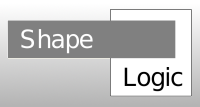Using ShapeLogic for general declarative programming
The declarative logic system is being refined substantially in ShapeLogic 0.9.
While the declarative logic system in ShapeLogic is geared towards image processing and computer vision, the logic system is not dependent on the vision system and it is possible to use ShapeLogic for other purposes.
This page considers possible other uses.
Current declarative programming system
Here is a look at current systems using declarative programming sorted by popularity. This was done in a highly unscientific way, and the popularity grouping is not meant to judge the quality of the systems.
Highly popular
- SQL
for storing and retrieving uniform data
- Spreadsheet
for simple calculations
- Mathematica
for advanced mathematics
- Make
for compiling C and C++
- Ant
for compiling Java
Somewhat popular
- Hibernate
and other ORM are starting to pick up steam
- List comprehension
from Haskell
is starting to make its way into main stream programming languages: Python, Scala, C#.
- IoC, Inversion of Control frameworks
like Spring
and Google Guice
.
Not a lot of momentum
- Expert systems
popular in the 80ies
- RETE engines
e.g. Jess
and Drools
get a little press coverage now
- Prolog
popular in the 80ies
- Oz
experimental functional and logic language
- CYC
maybe the most advanced and ambitious system for declarative logic and programming
Is there room for another declarative programming system?
Here are a few observations
- Declarative programming is not a one size fits all field
- The more powerful systems are not the most popular
- Simplicity seem to be a big factor in success, but not exclusively, Prolog is very simple, but lost momentum
- There is a place for custom systems
Goal for declarative programming in ShapeLogic
ShapeLogic is not a general purpose system.
It is meant as a simple system that will be able to do real work and be simple to learn and use.
Domains suitable for ShapeLogic
Domains where there are a limited number of objects with somewhat constant and limited sets of features.
Is there room for ShapeLogic as a general declarative programming system?
It is a long shot.
